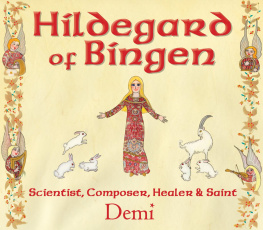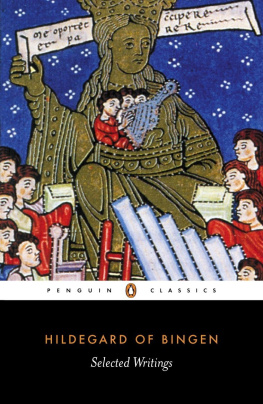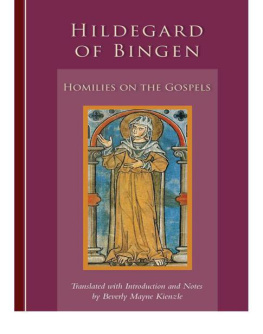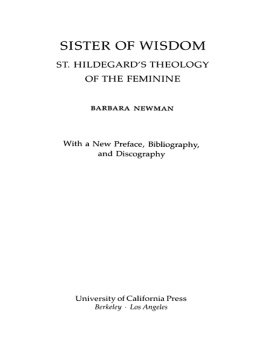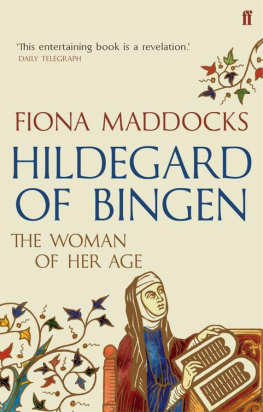T his book is dedicated to my sister, Hildegard, and all her sisters, past, present and to come, in a hope that their wisdom will cease to be repressed, ridiculed, forgotten and otherwise excluded from church, society and culture so that the earth might be blessed and mutuality might be the law of the land. My special thanks to my literal sisters, Terry, Roberta and Tricia, to my mother Beatrice and her sisters, Doris and Helen, and to my sister theologians who teach me so much, including Rosemary and Mary, Alexandra, Jean, Camille, and many more.

For more information about Matthew Foxs educational programs including a Masters degree in Creation Spirituality and the Doctor of Ministry degree see www.creationspirituality.org

Acknowledgments
I n addition to the persons to whom this book is dedicated I wish to thank Hildegards Benedictine sisters who so lovingly preserved Hildegards work over the violent centuries; Barbara and Gerry Clow for their publishing leadership and vision; Joan Ohanneson for her special Hildegardian gift; Dr. Bruce Hozeski for his persistence in getting Hildegard to English-speaking readers; Ron Miller, Robert Cunningham, Jerry Dybdal for their fine translating; Tristan for his companionship during my writing; Brendan Doyle for his steady encouragement; Marie Curran for her rapid typing; ICCS students for their assistance, questions, and eagerness to learn and live out creation mystics like Hildegard; Brian Swimme for his enthusiasm; Archbishop Hunthausen for his hospitality; Diane Schenker, James Savage and James L. Hermann for their memorable rendition of Ordo Virtutum in Seattles Cathedral; to Claudia Bourbeau for her index of the text; and to Collette Fugere for her editorial contribution to this new edition.
I
Hildegard:
Her Times and Her Illuminations
E ight hundred years ago, in the lush Rhineland valley, there lived a woman of extraordinary spirit and courage. In a century that gave birth to what has rightly been called the greatest Christian Renaissance, Hildegard of Bingen, whose lifetime spanned eighty percent of that century (1098-1179), stands out. In her lifetime, Chartres Cathedral rose from the grain fields of France with its delicious stained glass and its inimitable sculpture; Eleanor of Aquitaine and Thomas Becket strode the political stage; Frederick Barbarossa frightened peasant and pope alikeand Hildegard dressed him down; Bernard of Clairvaux both reformed monastic life and launched the Second Crusade; the Cathedral School of Paris was evolving into the University of Parisand its faculty approved of Hildegards writings after she travelled there in her mid-seventies with her books under her arm; Heloise and Abelard fell in love and left their tragic story for generations to ponder.
Through all the turmoil and creativity of the period, Hildegard carried on her work of preaching and teaching, of organizing and reforming, of establishing monasteries and journeying, of composing, writing, healing, studying, cajoling, and prophecying. Hildegard has left us over one hundred of her letters to emperors and popes, bishops, archbishops, nuns, and nobility. In addition, we have seventy-two songs, including a morality play set to music that can rightly be called an opera and for which Hildegard has recently been acclaimed for extending the vocabulary of medieval music radically beyond the norms and for creating a highly individual and unorthodox musical style.
A brief summary of her life would read as follows. She was born in the summer of 1098 at Bickelheim, on the left bank of the Nahe River, a tributary of the Rhine. The Nahe River flows into the Rhine at the town of Bingen. Her father was a German knight attached to the Castle of Bickelheim. Hildegard was the youngest of ten children and she admits to having had visionary experiences even as a little girl. Hildegard was educated under a tutor named Jutta, a holy anchoress with a cell consisting of several rooms attached to the Benedictine monastery of Mount St. Disibode. The Celtic connection is strong in Hildegard and her subsequent descendants of Rhineland mysticsDisibode was a Scotch-Irish monk who preached the Gospel in Hildegards region in the seventh century and who presumably settled on what is still known to be Mount St. Disibode. Hildegard wrote songs to St. Disibode and she wrote his biography. She did the same for another Celtic monk, St. Rupert, after whom she named her own monastery. Rupert had journeyed all the way to Salzburg, Austria where he founded the monastery which was later to house the cathedral choir for whom Mozart composed much of his music. At the age of eight, Hildegard joined Jutta and another woman in her quarters in the monastery (Celtic monasteries had no qualms about housing men and women in one community, though under separate roofs) and there she was educated in the Benedictine traditions of music, spinning, Biblical history, prayer, and work. At about eighteen years of age, Hildegard took the Benedictine habit.
In 1136 Jutta died and Hildegard was appointed to take over leadership of the female community, now numbering about one dozen persons. Within four years Hildegard had her celebrated spiritual awakening (see chapter 2 and Plate 2) in which she took command of her vocation and creative life. From this time on she took responsibility to share the visions and thoughts that had been incubating in her for years. She started to write. A secretary was appointed her, a young monk named Volmar, who took down what she dictated and put it into correct Latin grammatical form. Her first book was born over a ten-year period. She worked industriously on it from her forty-second to her fifty-second year. She called it Scivias (Know the Ways), and in it are contained most of the illuminations reproduced in this book. In the midst of this creative period, Pope Eugenius III came to Trier on the way to launching the Council of Rheims. Hearing of the celebrated woman at Disibode, he sent a commission to investigate. This commission, on interviewing Hildegard, found her competent and authentic and so reported to the pope. Her works were brought to the pope and his retinue, including Bernard, Abbot of Clairvaux, and the popes former teacher, and they were given papal approval. In his letter of approval, the pope encouraged Hildegard to keep writing. This she did. But she also wrote the pope admonishing him to work harder for reform in the church and its monasteries.
With Hildegards fame spreading, her community of sisters rapidly increased in number and she did not want to stay in the womens cramped quarters of Mount St. Disibode where the male quarters had expanded to cover almost all the available land space. She had her eye on Mount St. Rupert near Bingen and the Nahe River where she was raised. The monks of Disibode and their Abbot Kuno fought her tooth and nail on her decision to leave their monastery. She flatly refused their pleadings and demands to stay, and she and her sisters left Disibode for Rupertsburg around 1151, taking their dowries with them. In her new establishment Hildegard was consecrated abbess and her activities took on the air of a very determined leader. She recognized only the Archbishop of Mainz as her superior and freed her community totally from the control of her former abbot. She also secured the protection of the Emperor for her community. The monastery itself, whose construction she oversaw, contained such new features as plumbing that piped in water. That she saw her defiance of the abbot as a struggle in justice is clear from a letter she wrote him. The opening paragraph uses the word justice five times. I heard a voice speaking against the crimes which members of religious communities as well as lay people commit against justice: O justice, you are without a homeland; you are a foreigner in the city...Whence do I come? I come from the heart of the Father. And all lands are gathered around me ...I sigh at the ignorance of the people. She ends her letter to the abbot and her former community with an admonition to be converted to your God and be a light of the Kingearlier in her letter she declares that justice is the purple-clad beloved of the King. The strife between these two communities was not settled until shortly before Hildegards death, thirty-three years later.




